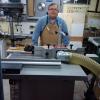I believe this is a matter of good business tactics to offer what the customer wants. However in a broader sense, an increasingly globalized world, as Dennis says, can't continue to use different methods of measurement, no matter what method is adopted. Business will eventually choose the most cost efficient path and the general population will slowly and begrudgingly adapt.





 Reply With Quote
Reply With Quote


 Or perhaps you might prefer kelvin?
Or perhaps you might prefer kelvin? 



